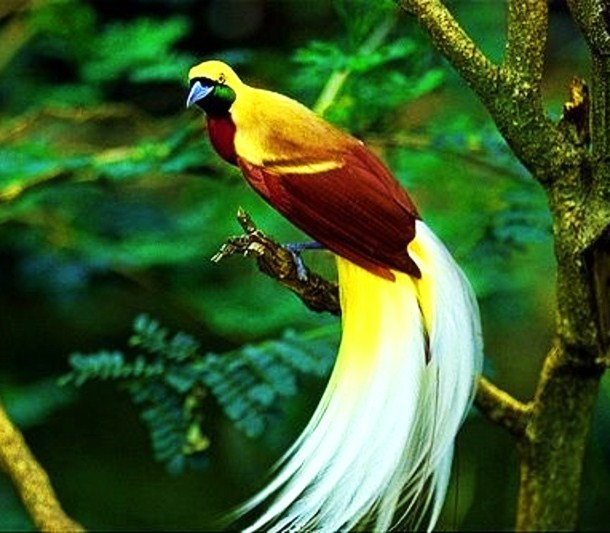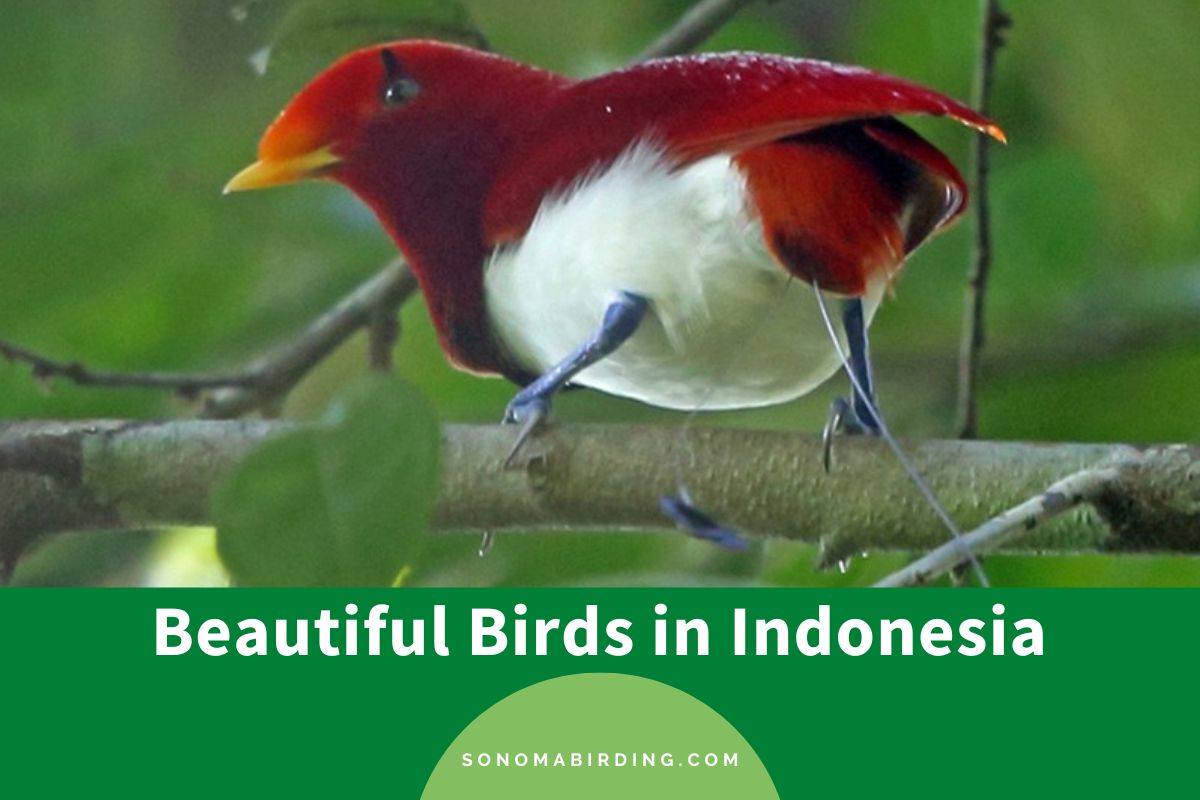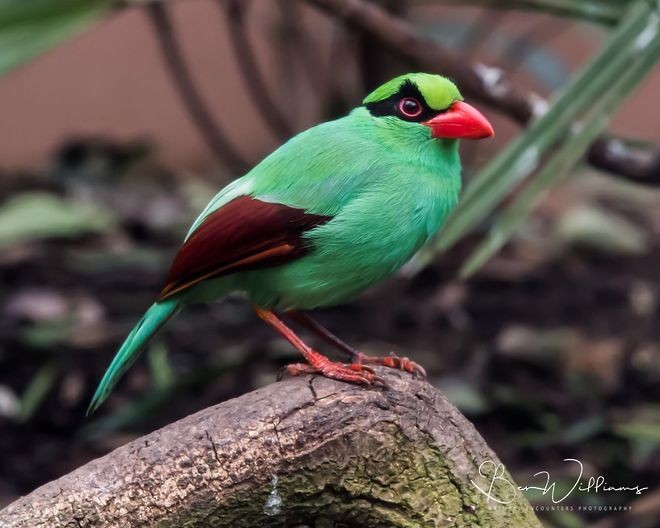If you’re a birdwatcher or nature enthusiast, you’ll be blown away by the stunning birdlife that Indonesia has to offer. With a rich variety of habitats and a diverse array of bird species, Indonesia is a paradise for birdwatchers. In this post, we’ll introduce you to some of the most beautiful birds that you can find in Indonesia. From the vibrant Green Peafowl to the majestic Javan Hawk-Eagle, these birds are a delight to behold.
So come along and discover the beauty of Indonesia’s avian inhabitants!
1. King Bird-of-paradise
Scientific name: Cicinnurus regius
Length: 16-19 centimeters (6.3-7.5 inches)
Body mass: 45-64 grams in males; 36-59 grams in females
Lifespan: 5-8 years
Rightly called King among all the birds-of-paradise, the King Bird-of-paradise is both the smallest and most attractively colored member of the family. These inconspicuous birds are the common inhabitants of the islands of Missol, Salawati, Yapen, and Aru in Indonesia.
King birds-of-paradise are strongly sexually dimorphic, with the males being the more attractive sex. Their head, throat, back, wings, tail, and rump are all colored in a vivid, metallic shade of crimson. There’s a bold black patch on their throat, below which the rest of the underbody is stark white. They also have thin, vertical black marks on top of each eye.
On the other hand, their female counterparts have a dull, olive-green plumage, which has a darker shade on their head and upper body and a lighter one on the undersides. However, both sexes have dark eyes, orange bills, and blue legs and feet.
2. Green Peafowl
Scientific name: Pavo muticus
Length: 1.8-3 meters (5.9-9.8 feet) in males; 1-1.1 meters (3.2-3.5 feet) in females
Body mass: 3.8-5 kilograms in males; 1-1.2 kilograms in females
Lifespan: 10-25 years
The Green Peafowls are one of the three peafowl species in the world and the only one found in Indonesia. These beautiful pheasant birds, whose population has an endangered status, are found in the forests on the island of Java.
Much like other members of the pheasant family, Green Peafowls display a strong dimorphism among their sexes, with the males being larger, heavier, and possessing longer upper tail coverts.
However, in plumage, they’re quite similar. Both sexes possess an iridescent greenish-blue overall plumage, whitish skin patches on their face, and shafted crests. Only the crest of males is thinner and taller than that of the females.
3. Palm Cockatoo
Scientific name: Probosciger aterrimus
Length: 55-60 centimeters (22-24 inches)
Body mass: 910 grams – 1.2 kilograms
Lifespan: 40-60 years
Also referred to as Goliath Cockatoo, the Palm Cockatoos are a large parrot species endemic to the rainforests and woodlands of Indonesia, New Guinea, and Australia. In Indonesia, you can find them on Aru Island.
Palm Cockatoos have a predominantly smoky-grey colored body, including their legs and massive bills. Atop their head, you will notice a large, feathery crest that sets them apart from most parrots within their range.
They have brown irises, two large red cheek patches, and a black patch right above their bills, from where their crest emerges. Both sexes have identical plumages; only the bills of the males are relatively larger.
4. Twelve-wired Bird-of-paradise
Scientific name: Seleucidis melanoleucus
Length: 33 centimeters (12.9 inches)
Body mass: 170-220 grams in males; 160-180 grams in females
Lifespan: 5-8 years
Named after the twelve wire-like plumes extending from the males’ vent, the Twelve-wired Birds-of-paradise are a bird-of-paradise species endemic to Indonesia and New Guinea. In Indonesia, you can find them occurring in the swamp forests and lowlands of Salawati Island.
The adults of these birds-of-paradise are highly sexually dimorphic. The males are heavier and have an overall dark body colored blackish-purple; only their belly and rump are yellow.
On the other hand, the females have a black head, brown back, wings, and tail, and a strongly barred buff underbody. Both sexes have dark bills, reddish irises, feet, and legs.
5. Bali Myna
Scientific name: Leucopsar rothschildi
Length: 25 centimeters (9.8 inches)
Body mass: 70-115 grams
Lifespan: 5-8 years
Also referred to as Rothschild’s Mynah to commemorate Lord Rothschild, the British ornithologist, the Bali Mynas are a critically endangered myna species endemic to Indonesia.
As their name indicates, their range is limited to the island of Bali. On the island, they’re colloquially referred to as Jalak Bali.
Bali Mynas have a striking, snowy white plumage all over their body, with only their wing and tail tips being black. They also have a white crest atop their head, which is generally drooping down their back.
Their eyes are black, and the bills are dark brown with a yellow tip. A blue, bare skin patch surrounds their eyes and is also the color of their legs and feet.
Did you know? Because Bali Mynas are the only vertebrate species endemic to Bali, which is why they were designated as the faunal emblem of the island in 1991.
6. Pink-headed Fruit Dove
Scientific name: Ptilinopus porphyreus
Length: 29 centimeters (11.4 inches)
Body mass: 153-195 grams
Lifespan: 8-12 years
Also referred to as Temminck’s Fruit Dove, the Pink-headed Fruit Doves are a medium-sized pigeon species endemic to the mountain forests of Indonesia. You can find their widespread population on the islands of Sumatra, Java, and Bali.
True to their name, Pink-headed Fruit Doves have a pale pink head and throat, and a bold white breast band. Their underbody below the band is colored grey, while their back, wings, and tail are dark olive green. They have black eyes, grey bills, pink legs, and feet.
Both sexes of these fruit doves have similar plumage, although the females have a lesser prominent breast band.
7. Lesser Bird-of-paradise

Scientific name: Paradisaea minor
Length: 32 centimeters (12.5 inches)
Body mass: 183-300 grams in males; 140-210 grams in females
Lifespan: 4-8 years
The Lesser Birds-of-paradise are medium-sized birds-of-paradise endemic to the forests of Indonesia and New Guinea. Within Indonesia, you can find them on the West Papua islands of Yapen and Misool.
Lesser Birds-of-paradise somewhat resemble the Greater Birds-of-paradise in appearance, with a smaller size and slightly different coloration. The adults of this species display a strong dimorphism.
The males have a yellow face, an emerald-green throat, and brown back, wings, and tail. Their ornamental flank plumes have a yellow base and white tips. They also possess a pair of wire-like plumes, which, along with the ornamental flanks, are absent in the females.
Female Lesser Birds-of-paradise appear rather plain and have a maroon plumage, with a reddish head and pale-yellow underparts. However, both sexes have golden irises, grey bills, legs, and feet.
8. Elegant Pitta
Scientific name: Pitta elegans
Length: 19 centimeters (7.5 inches)
Body mass: 47-77 grams
Lifespan: 4-5 years
The Elegant Pittas are a colorful pitta species endemic to the dry and lowland forests of Indonesia. You can find them on the islands of Maluku and Lesser Sunda.
Elegant Pittas have a black head, eyes, and bills, with a black stripe extending below their chin. Their underparts are puff-colored, except for a black patch on their mid-belly and a red rump.
A thin buff stripe runs along their head; their wings are green, with a vibrant turquoise stripe on each wing. Both sexes of this species are identical in plumage and display no dimorphism, much like other pitta species.
9. Cerulean Kingfisher
Scientific name: Alcedo coerulescens
Length: 13 centimeters (5.1 inches)
Body mass: 12-18 grams
Lifespan: 4-7 years
Quite similar to the Common Kingfishers in size and plumage, the Cerulean Kingfishers are a kingfisher species endemic to the low-lying areas of Indonesia. These kingfishers are commonly found in Sumbawa, Java, Bali, Sumatra, Lombok, and the Kangean islands.
Cerulean Kingfishers possess a white and blue plumage, with a cerulean blue head, back, wings, tail, and chest band. They have two white patches on each side of their neck, and a white patch on their chin, belly, and rump. Their eyes, bills, legs, and feet are all black. Both sexes look identical.
10. Red Bird-of-paradise
Scientific name: Paradisaea rubra
Length: 33 centimeters (12.9 inches)
Body mass: 158-224 grams in males; 115-208 grams in females
Lifespan: 7-8 years
Colloquially referred to as Cendrawasih Merah, the Red Birds-of-paradise are a near-threatened bird-of-paradise species native to the rainforests of Batanta and Waigeo islands of West Papua, Indonesia.
Like other birds-of-paradise, these birds are also strongly sexually dimorphic. Although both sexes have yellow heads, throats, and mantles with brownish lower bodies, their faces are quite different.
The males have dark, wattle-like skin around their eyes and a green chin, while the females have plain brown face. They also lack the pair of corkscrew-shaped ornamental plumes that extend from the males’ tails. Both sexes have yellow bills, dark eyes, legs, and feet.
11. Javan Green Magpie
Scientific name: Cissa thalassina
Length: 24-30 centimeters (9.4-11.8 inches)
Body mass: 124-130 grams
Lifespan: 3-5 years
The Javan Green Magpies are a critically endangered magpie species native to the montane forests of Javan island. As their name indicates, these corvids have predominantly green plumage.
Javan Green Magpies have dark eyes surrounded by orange eye rings, and a uniquely-shaped black mask that gives them a somewhat crooked look. They have broad, orange bills, legs, and feet. Their secondary feathers are rich brown with bold white patches above them. Much like other corvid species, both sexes of these magpies have identical plumage.
12. Scarlet Minivet
Scientific name: Pericrocotus speciosus
Length: 17-22 centimeters (6.6-8.6 inches)
Body mass: 19-24 grams
Lifespan: 9-11 years
Belonging to the family of Cuckooshrikes and Allies, the Scarlet Minivets are a small passerine bird species endemic to the tropical forests of Indonesia, China, the Philippines, and northeast India.
These minivets display a strong sexual dimorphism, with the males harboring the scarlet plumage that the species has been named after. They have a black head, mantle, and wings with prominent scarlet patches on them. Their tail is colored in a mix of black and scarlet.
The female Scarlet Minivets have a yellow face instead, with a grey crown and a grey stripe running across their eyes. Their mantle is grey as well, but the wings and tail are black, with yellow patches on them. The eyes, bills, legs, and feet of both sexes are dark.
13. White Cockatoo
Scientific name: Cacatua alba
Length: 43-46 centimeters (17-18 inches)
Body mass: 500-630 grams
Wingspan: 55 centimeters (22 inches)
Lifespan: 40-60 years
Also referred to as Umbrella Cockatoo, the White Cockatoos are an endangered cockatoo species endemic to the rainforests of Indonesia. You can find them on the Moluccan islands of Mandioli, Bacan, Halmahera, Tidore, Kasiruta, and Ternate.
As their name indicates, these cockatoos have an all-white plumage. Their most striking physical feature is the large white crest resting atop their head that extends in a semicircular, almost umbrella-like shape when they’re surprised.
The adults of this species sport the same plumage but display dimorphism in size, with the males having larger heads and bills than their female counterparts. Both sexes have dark eyes, grey bills, feet, and legs.
14. Black-and-red Broadbill
Scientific name: Cymbirhynchus macrorhynchos
Length: 21-24 centimeters (8.3-9.4 inches)
Body mass: 51-65 grams
The Black-and-red Broadbills are a large broadbill species endemic to Southeast Asia, where they’re commonly found in Indonesia, Cambodia, Myanmar, Brunei, Thailand, Vietnam, and Malaysia.
These broadbills are well-known for their distinctly-colored plumage. They have a black head, back, wings, and tail, with a black throat band and a bold maroon chin stripe. The rest of their underbody is maroon as well, with a large maroon patch on their lower back, between the wings. They have yellow flanks and white wing stripes.
Their irises are blue, and so are their legs, feet, and upper mandible; only the lower mandible is yellow. The adults of this species have identical plumages but show dimorphism in their size, with the females being the smaller sex.
15. Southern Cassowary

Scientific name: Casuarius casuarius
Length: 1-1.7 meters (3.2-5.5 feet)
Body mass: 29-34 kilograms in males; 58 kilograms in females
Wingspan: 1.5-2 meters (4.9-6.5 feet)
Lifespan: 40-50 years
Also referred to as Australian Cassowary and Double-wattled Cassowary, the Southern Cassowaries are large flightless birds native to the rainforests of Australia, New Guinea, and Indonesia. In Indonesia, these ratites are widespread on the island of Aru. They’re the largest among all three extant cassowaries in the world.
Southern Cassowaries have primarily black plumage covered in tough, bristle-like hairs all over their body. Their head is bare and blue, with a solid brown casque sitting on top, joined to their similar-colored bills. On their neck, you’ll find two red wattles, which lend them their alternative name. They have long legs and large, three-toed feet.
Although the adults of this species, sport the same plumage, they are strongly dimorphic. The females are larger and heavier, have a larger casque, brighter heads and wattles, and are the dominant sex.
16. Pied Stilt
Scientific name: Himantopus leucocephalus
Length: 36 centimeters (14 inches)
Body mass: 140-160 grams
Wingspan: 67 centimeters (26.5 inches)
Lifespan: 19-20 years
Also referred to as White-headed Stilt, the Pied Stilts are a wading bird with a widespread population throughout Southeast Asia. Often considered a subspecies of Black-winged Stilts, these birds are common inhabitants of Sulawesi, Java, and Sumatra within Indonesia and reside in shallow-water habitats.
Pied Stilts have a mainly black-and-white body, save for their long, pink legs. Their face, neck, mantle, and underbody are all white, while the wings and tail are black. There’s also a black patch on the back of their head that extends all the way to their mantle.
You can also see traces of grey in their tail feathers. They have red irises and eyelids with slender, black bills.
17. Black Baza
Scientific name: Aviceda leuphotes
Length: 30-35 centimeters (11.8-13.7 inches)
Body mass: 168-240 grams
Wingspan: 66-80 centimeters (25-31 inches)
Belonging to the genus of Cuckoo-hawks, the Black Bazas are small raptors native to the forests of the eastern Himalayas, northeastern India, China, and Southeast Asia. While they’re not permanent residents of Indonesia, their migratory populations are found on its islands during winter.
Black Bazas are quite distinctly colored for a raptor. They have a slate-grey head, face, back, wings, and tail, with occasional rufous and white wing patches. On their throat, you’ll spot a bold, almost V-shaped white patch. The rest of their underbody is buff-colored and has uniformly drawn brown bars.
These birds of prey also have a distinctive grey crest atop their heads which is uncommon in their family. Both sexes appear more or less alike; only the females have a more strongly barred underbody than their male counterparts.
18. Javan Flameback

Scientific name: Chrysocolaptes strictus
Length: 28-32 centimeters (11-12.5 inches)
Body mass: 67-100 grams
Lifespan: 8-11 years
Found in the forests of Bali, Java, and Kangean Islands, the Javan Flamebacks are an Indonesian woodpecker species. Although some people consider them to be a subspecies of Greater Flamebacks, they’re a separate species.
In appearance, Javan Flamebacks closely resemble Greater Flamebacks; they have the same white head striped with a black, mottled-white underbody, greenish-golden wings, black tail, and golden eyes.
The plumage of both sexes has no other differences except for their crest. The males possess a red feathered crest, while in females, it’s golden.
19. Knobbed Hornbill
Scientific name: Rhyticeros cassidix
Length: 70-80 centimeters (27-31 inches)
Body mass: 2.3-2.5 kilograms
Lifespan: 32-38 years
Endemic to the evergreen forests of Indonesia, the Knobbed Hornbills are a vulnerable hornbill species whose population faces the threat of extinction due to hunting and deforestation. They’re declared as the fauna symbol of the South Sulawesi province.
Both sexes of Knobbed Hornbills have identical black bodies with white tails; the differences lie in their face.
The males have a pale buff-colored face, with a bulbous, red casque resting atop their massive yellow bills; their eyes are orangish in color. On the other hand, the females possess a black face; their casques are yellow while the eyes are brown.
20. Javan Hawk-eagle
Scientific name: Nisaetus bartelsi
Length: 60 centimeters (23.6 inches)
Lifespan: 14 years
Last on our list is Indonesia’s national bird, the Javan Hawk-eagle. True to their name, these raptors commonly inhabit the humid forests on the island of Java. Declared to be an endangered species, these hawk-eagles are one of the rarest raptors in the whole world.
In Indonesia, they’re more popularly referred to as Garuda, and are believed to be the same birds mentioned time and again in the Hindu and Buddhist mythologies.
Javan Hawk-eagles have a strongly barred plumage; their head, neck, and back are rufous, while the underbody is mottled black. Their long legs are significantly feathered, with yellow-colored feet and sharp talons. Atop their head, you’ll notice a distinct, erect crest of brown feathers. The eyes are golden, while the strongly crooked bills are dark greyish.
Related articles:
25 Beautiful Birds in Uganda to Look Out For


















